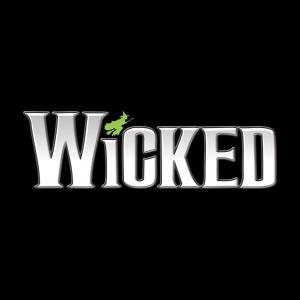
In addition to being the season’s smash hit and having a cast album that’s the highest-ranked on the charts since Rent, Stephen Schwartz’s and Winnie Holzman’s Wicked has now added another distinction to its credit — one that many hit musicals never attained. Its source material, Gregory Maguire’s novel, has just been reissued with the show’s logo on its cover.
No, this sort of thing is not unprecedented, but it’s pretty rare. As I look at my shelf of adaptations, I see Broadway logos on my copies of Les Misérables, The Phantom of the Opera, Aspects of Love, and Whistle Down the Wind. But long before British musicals began pasting show logos on their source novels, American musicals did it from time to time.
Granted, it often happened only after the Hollywood version was made. My September 1958 Cardinal 35-cent paperback of Douglas Wallop’s The Year the Yankees Lost the Pennant sported a photo of Gwen Verdon in her Lola outfit, wearing a sandwich sign that reads: “The book from which the smash Broadway musical and the spectacular Warner Bros. motion picture Damn Yankees starring Tab Hunter and Gwen Verdon was adapted.” Hmmm. Given the order of that billing, maybe a musical theater enthusiast wouldn’t want this edition after all.
H.G. Wells’s Kipps was released in 1968 as a Dell 60-cent paperback that showed Tommy Steele holding a banjo: the film logo of Half a Sixpence, with that title printed underneath his image. On the back cover was stated, “Kipps now comes to life as a spectacular musical film…one of the motion picture treats
of any year.” (This suggests that the ad man wrote the lines before he actually saw the movie.)
In an industry where there are “movie tie-in” novelizations (Bye Bye Birdie, Funny Girl, Paint Your Wagon, and The Unsinkable Molly Brown all got them), one might expect that a pre-existing novel would use the logo of an upcoming movie based upon it, what with all that Hollywood exposure. But it’s something else entirely for a Broadway musical to cause a book publisher’s art department to believe that the expense of a new cover is warranted. Stephen Flaherty and Lynn Ahrens have seen it happen twice for their shows. First came the 1990 Owl edition of Rosa Guy’s My Love, My Love: “The book on which the hit musical Once on This Island is based,” read the banner above the show’s logo. Then, in 1996, there was the Plume trade paperback of Ragtime: “The classic novel — now a magnificent musical,” the front cover stated accurately. On the back, though, was a more ominous sentence: “Now an epic new musical from the Tony Award-winning producer Livent Inc.”
In between those, in 1989, The Secret Garden was reissued by Tor books with the Broadway logo on the front and, on the back, not only the name of the creative team but also the helpful plug that “The Secret Garden is playing at the St. James Theatre, 246 West 44th Street, New York.” In April 1992, The Scarlet Pimpernel tried the same marketing ploy, with the logo on the front cover and “The new musical adventure on Broadway at the Minskoff Theatre” on the back. Hey, as the chorus sang in Ari — whose logo never graced its source novel, Exodus — “The Lord helps those who help themselves.”
But long before any of the above examples, in 1961, Ballantine issued a second edition of Shepherd Mead’s mock manual How to Succeed in Business Without Really Trying with the show’s logo on the cover. “The original book of the smash Broadway musical,” it bragged, “with complete photos of the cast.” Well, I wouldn’t say “complete,” but there were eight snapshots bisecting the book: Finch on his window-washer apparatus, Finch giving Miss Jones a flower, Smitty upset about the empty coffee urn, Frump’s gaga look as he sees Hedy LaRue for the first time, Finch telling Rosemary that he can’t have lunch after all, Biggley doing his knitting, Finch leading everyone in “Brotherhood of Man,” and Finch deep in thought reading this very manual. On the back cover was printed this droll paragraph: “It was only natural that a book of such deep wisdom should someday be made into Broadway’s Greatest Musical Hit. And now, thanks to Abe Burrows and Frank Loesser, its message lives again in pulsating drama and catchy songs so that even those who cannot read or write can find success.”

If you’re thinking that a musical must be a smash hit to get its logo on the original novel, I have but one word to refute this: Carrie. Yes, indeed! In 1988, Signet re-released the Stephen King novel with the show’s stylistic three-red-line, three-white-line, one-red-teardrop logo. “The 4-million copy bestseller is now an electrifying musical,” said a banner at the top of the book. On the back was the truer-words-were-never-spoken line “There’s never been a musical like Carrie,” followed by the credits for the show. So while book collectors always want to have the first edition of any tome, musical theater enthusiasts only want the 61st edition of Stephen King’s Carrie.
And while we’re on the subject, let me point out two other novels that made reference to Broadway — though they didn’t offer logos, for the good reason that the musicals never came to be. Get a copy of the 1964 third printing of the 95-cent Ballantine novel One Hundred Dollar Misunderstanding by Robert Gover and you’ll find on the back cover, “Now in production: A Broadway musical of One Hundred Dollar Misunderstanding to be produced by Hillard Elkins, who will also bring to Broadway musical adaptations of Frederic Morton’s The Rothschilds and Clifford Odets’ Golden Boy starring Sammy Davis, Jr.” Well, two out of three ain’t bad.
Finally, I have a 1954, 35-cent Ballantine paperback of a novel called The Big Ball of Wax whose plot, according to the back cover, begins with the fact that “She was only a striptease evangelist…” After four more sentences describing the story, there’s this fascinating nugget: “With girls by the score, and the score by Harold Rome, The Big Ball of Wax is the book on which Moss Hart’s upcoming new song-studded, laugh-littered musical In the Pink is based.” And who wrote this novel that spurred this musical that died aborning? The aforementioned Shepherd Mead, who at least got to see one of his books turned into a great big Broadway show.
********************
[To contact Peter Filichia directly, e-mail him at [email protected]]








